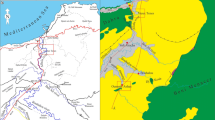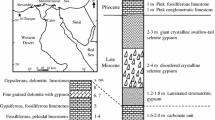Abstract
The New Jersey continental shelf extends 150 km off the shoreline. During IODP Expedition 313, siliciclastic deposits of late Eocene to late Pleistocene age were drilled down to 631, 669 and 755 m below seafloor at sites 27A, 28A and 29A respectively in very shallow waters (33.5 to 36 m depth). Pore water salinities display multilayered brackish-salty-brine units 10 to 170 m thick, where low-salinity water is preferentially stored in fine-grained sediments. The sharp boundaries of these buried aquifers are often marked by cemented layers a few centimetres thick. The mineralogy and scanning electron microscope observations of these layers show two phases of cementation by authigenic minerals: (1) the early carbonate cement is frequently associated with pyrite, and (2) the late silicate cement infills the residual porosity. The isotopic compositions of the carbonate cements vary widely: −2.4 < δ18O ‰ VPDB < +2.8; −15.1 < δ13C ‰ VPDB < +15.6. The δ18O values indicate that the carbonate cements precipitated with pore waters comprising variable mixtures of seawater and 18O-depleted fresh water originating from submarine groundwater discharge. The δ13C values of the carbonate cements are related to organic matter diagenesis, providing 13C-depleted dissolved inorganic carbon during bacterial sulphate reduction and anaerobic oxidation of methane, and 13C-rich dissolved inorganic carbon during methanogenesis. The diagenetic cementation processes included chemical weathering of reactive silicate minerals by the CO2-rich pore waters issued from organic matter diagenesis that released bicarbonate, cations and dissolved silica, which were further precipitated as carbonate and silicate cements. The estimated range of temperature (18±4 °C) during carbonate precipitation is consistent with carbonate cementation at moderate burial depths; however, silicate cementation occurred later during diagenesis at deeper burial depths.








Similar content being viewed by others
References
Austin JA Jr, Christie-Blick N, Malone MJ et al (1998) Proc ODP, Init Repts 174A. Ocean Drilling Program, College Station, TX. doi:10.2973/odp.proc.ir.174a.1998
Burnett WC, Bokuniewicz H, Huettel M, Moore WS, Taniguchi M (2003) Groundwater and pore water inputs to the coastal zone. Biogeochemistry 66:3–33
Carothers WW, Adami LH, Rosenbauer RJ (1988) Experimental oxygen isotope fractionation between siderite-water and phosphoric acid-liberated CO2-siderite. Geochim Cosmochim Acta 33:49–64
Christie-Blick N, Austin JA Jr, Shipboard Scientific Party (1998) Introduction: Oligocene to pleistocene eustatic change at the New Jersey continental margin. A test of sequence stratigraphy. In: Austin JA Jr, Christie-Blick N, Malone MJ et al., Proceedings of the Ocean Drilling Program Initial Reports 174A:5–16
Claypool GE, Threlkeld CN (1983) Anoxic diagenesis and methane generation in sediments of the Blake outer ridge, deep sea drilling project site 533, leg 76. In: Sheridan RE, Gradstein FM et al (eds) Init Repts DSDP 76. US Govt Printing Office, Washington, pp 391–402
Cohen D, Person M, Wang P, Gable CW, Hutchinson D, Marksamer A, Dugan B, Kooi H, Groen K, Lizarralde D, Evans RL, Day-Lewis FD, Lane JW Jr (2010) Origin and extent of fresh paleowaters on the Atlantic continental shelf, USA. Groundwater 48(1):143–158
Craig H (1957) Isotopic standards for carbon and oxygen and correction factors for mass-spectrometric analysis of carbon dioxide. Geochim Cosmochim Acta 12:133–149
Flörke OW, Hollmann R, von Rad U, Rösch H (1976) Intergrowth and twinning in opal-CT lepispheres. Contrib Mineral Petrol 58:235–242
Fritz P, Smith DGW (1970) The isotopic composition of secondary dolomites. Geochim Cosmochim Acta 34:1161–1173
Gonfiantini R, Stichler W, Kozanski K (1995) Standards and intercomparison materials distributed by the international atomic energy agency for stable isotope measurements. In: Reference and Intercomparison materials for stable isotopes of light elements, IAEA-TECDOC-825. IAEA, Vienna, pp 13–29
Hathaway JC, Poag CW, Valentine PC, Miller RE, Schultz DM, Manheim FT, Kohout FA, Bothner MH, Sangrey DA (1979) US geological survey core drilling on the Atlantic shelf. Science 206(4418):515–527. doi:10.1126/science.206.4418.515
Inwood J, Lofi J, Davies S, Basile C, Bjerum C, Mountain G, Proust JN, Otsuka H, Valppu H (2013) Statistical classification of log response as an indicator of facies variation during changes in sea level: integrated ocean drilling program expedition 313. Geosphere 9(4):1025–1043. doi:10.1130/GES00913.1
Kastner M (1979) Silica polymorphs. In: marine minerals. Reviews in mineralogy, vol 6. Mineralogical Society of America, pp 99–109
Keller MA, Isaacs CM (1985) An evaluation of temperature scales for silica diagenesis in diatomaceous sequences including a new approach bases on the Miocene Monterey formation, California. Geo-Mar Lett 5:31–35
Kim ST, O’Neil JR (1997) Equilibrium and non-equilibrium oxygen isotope effects in synthetic carbonates. Geochim Cosmochim Acta 61(16):3461–3475
Lofi J, Inwood J, Proust JN, Monteverde DH, Loggia D, Basile C, Otsuka T, Stadler S, Mottl MJ, Fehr A, Pezard PA (2013) Fresh-water and salt-water distribution in passive margin sediments: insights from integrated ocean drilling program expedition 313 on the New Jersey margin. Geosphere 9(4):1009–1024. doi:10.1130/GES00855.1
Malone MJ, Claypool G, Martin JB, Dickens GR (2002) Variable methane fluxes in shallow marine systems over geologic time. The composition and origin of pore waters and authigenic carbonates on the New Jersey shelf. Mar Geol 189:175–196
Miller KG, Snyder SW (eds) (1997) Proc ODP, Sci Results 150X. Ocean Drilling Program, College Station, TX. doi:10.2973/odp.proc.sr.150X.1997
Miller KG et al (1994) Proc ODP, Init Repts 150X. Ocean Drilling Program, College Station, TX. doi:10.2973/odp.proc.ir.150X.1994
Moore WS (1999) The subterranean estuary: a reaction zone of ground water and sea water. Mar Chem 65:111–125
Mountain GS, Miller KG, Blum P et al (1994) Proc ODP, Init Repts 150. Ocean Drilling Program, College Station, TX. doi:10.2973/odp.proc.ir.150.1994
Mountain GS, Proust JN, McInroy D, Cotterill C, the Expedition 313 Scientists (2010) Proceedings of the Integrated Ocean drilling Program, vol 313. Integrated Ocean Drilling Program Management International, Tokyo. doi:10.2204/iodp.proc.313.2010
Post VEA, Groen J, Kooi H, Person M, Ge S, Edmunds WM (2013) Offshore fresh groundwater reserves as a global phenomenon. Nature 504:71–78. doi:10.1038/nature12858
Rubinson M, Clayton RN (1969) Carbon 13 fractionation between aragonite and calcite. Geochim Cosmochim Acta 33:997–1022
Sheppard SMF, Schwarcz HP (1970) Fractionation of carbon and oxygen isotopes and magnesium between coexisting metamorphic calcite and dolomite. Contrib Mineral Petrol 26:161–198
Skarke A, Ruppel C, Kodis M, Brothers D, Lobecker E (2014) Widespread methane leakage from the sea floor on the northern US Atlantic margin. Nat Geosci 7:657–661. doi:10.1038/NGEO2232
van Geldern R, Hayashi T, Böttcher ME, Mottl MJ, Barth JAC, Stadler S (2013) Stable isotope geochemistry of pore waters and marine sediments from the New Jersey shelf: methane formation and fluid origin. Geosphere 9(1):96–112. doi:10.1130/GES00859.1
Whiticar MJ (1999) Carbon and hydrogen isotope systematics of bacterial formation and oxidation of methane. Chem Geol 161:291–314
Acknowledgements
This research used samples and data provided by the Integrated Ocean Drilling Program (IODP) and the International Continental Scientific Drilling Program (ICDP). The authors would like to thank Gerald Dickens for his very constructive review comments, which helped improve the article.
Author information
Authors and Affiliations
Corresponding author
Ethics declarations
Conflict of interest
The authors declare that there is no conflict of interest with third parties.
Rights and permissions
About this article
Cite this article
Pierre, C., Blanc-Valleron, MM., Boudouma, O. et al. Carbonate and silicate cementation of siliciclastic sediments of the New Jersey shelf (IODP Expedition 313): relation with organic matter diagenesis and submarine groundwater discharge. Geo-Mar Lett 37, 537–547 (2017). https://doi.org/10.1007/s00367-017-0506-6
Received:
Accepted:
Published:
Issue Date:
DOI: https://doi.org/10.1007/s00367-017-0506-6




